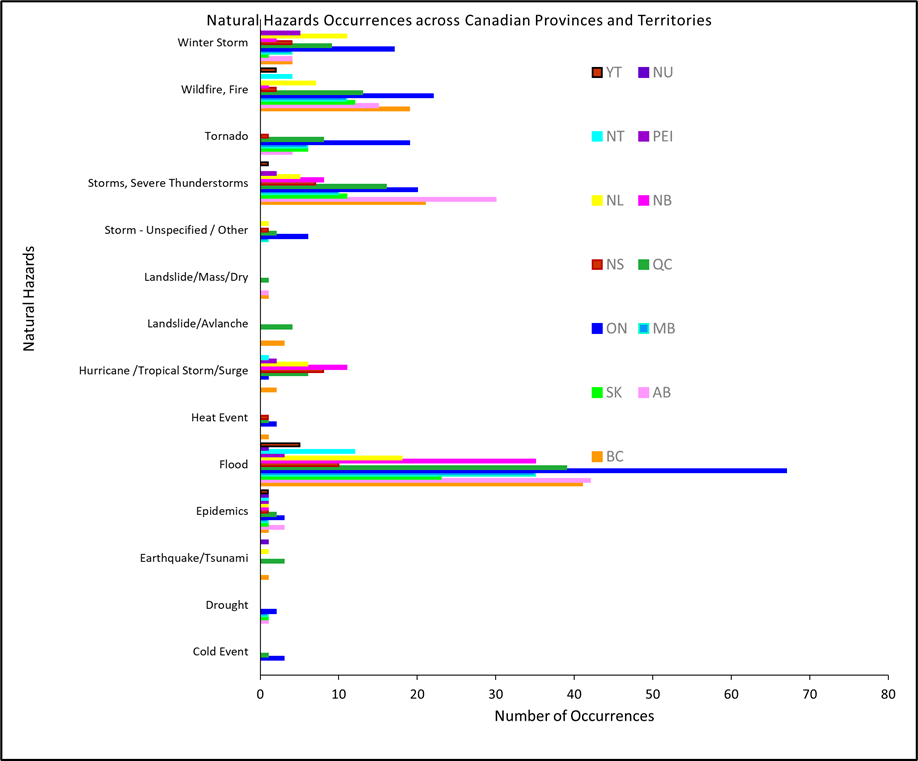Disaster Risk in Canada – A Data-Driven Discussion
DOI:
https://doi.org/10.25071/7penv229Keywords:
Disaster Risk, Canada, Resilience, Risk Reduction, Vulnerability, Historical dataAbstract
In a haphazardly changing climate, decision makers and practitioners need new insights based on historical disasters, demographic and socioeconomic shifts, and modifications in the built environment. The COVID-19 has exposed systemic vulnerabilities at all levels. Reflections on past disasters and practices regarding measures to reduce disaster losses, overlaid with insightful understandings and interpretations to suit current times, must allow for new pathways. This study attempts to achieve just that. It examines natural disasters in Canada since the 1900s as well as census data to track the demographics and socioeconomic scenarios. At the initial assessment, considering the most frequent natural disasters (floods, extreme cold, severe thunderstorms, tropical storms and storm surge, landslides, drought, wildfires, earthquakes, and epidemics), Canada experienced 844 events since 1900. A province-based distribution of these disasters suggests that Ontario is ranked first with 158 major events, followed by Quebec, Alberta, and British Columbia, with over 100 events each. The maritime provinces have also had their share of disasters, and so have the northern communities and territories. In terms of population changes, between 1901 and 2019, Ontario has grown over 560%, Quebec 50%, Alberta 325%, and BC a whopping 2,700%.
The study specifically explores the following: disaster types and the scale of their impact on people, properties, and the environment; the demographic and socioeconomic status; an investigation of what measures are currently in place to ensure the building of resilience and coping capacity at the institutional level. The measures include provincial and federal tools for hazard identification and risk assessment that inform policy, emergency response plans, landuse planning, etc. Further investigation is recommended to cover a wide range of vulnerability indicators of the population, as well as the institutional systems and policies in place for developing a robust set of tools to mitigate disaster impacts in the future. This is a preliminary analysis of the entire country in the hope of making a case for a national strategy for disaster adaptive capacities and resilience and climate adaptation.
References
Agrawal, N., Elliott M., Simonovic, S.P. (2020). Risk and resilience: A case study of perception versus reality for flood management. Water, 12(5), 1254.
British Columbia Emergency Preparedness. (2004). Hazard. http://142.34.249.54/toolkit.html
British Columbia Public Safety and Emergency Services. (2019). Hazard, Risk and Vulnerability Analysis [HRVA]. http://hrva.embc.gov.bc.ca/toolkit.html
CBC News. (2020, November 23). ‘We have reached a precarious point’: Alberta now has 13,166 active cases of COVID-19. https://www.cbc.ca/news/canada/edmonton/alberta-covid-19-coronavirus-hinshaw-ndp-notley-1.5812610
Centre for Research on the Epidemiology of Disasters (CRED). (2009). EM-DAT. The International Disaster Database. https://www.emdat.be/explanatory-notes
Centre for Research on the Epidemiology of Disasters (CRED). (2020). EM-DAT. The International Disaster Database. www.emdat.be
Cutter, S.L., Barnes, L., Berry, M., Burton, C., Evans, E., Tate, E. (2008). A place-based model for understanding community resilience to natural disasters. Glob. Environ. Chang., 18, 598–606.
Cutter, S.L., Boru, B.J., Shirley, W.L. (2003). Social vulnerability to environmental hazards. Soc. Sci. Q. , 84, 242–261.
Government of Canada. (2019). Emergency Management Strategy for Canada: Toward a Resilient 2030; Public Safety Canada: Ottawa, ON, Canada; ISBN 978-0-660-29248-9.
Kuhlick, C., Scolobig, A., Tapsell, S., Steinführer, A., Marchi, B.D. (2011). Contextualizing Social Vulnerability: Findings from Case Studies across Europe; Springer Science & Business Media, NY, USA, 2011.
Messner, F., Meyer, V. (2006). Flood damage, vulnerability and risk perception—Challenges for flood damage research. In Flood Risk Management: Hazards, Vulnerability and Mitigation Measures; NATO Science Series; Schanze, J., Zeman, E., Marsalek, J., Eds.; Springer: Dordrecht, The Netherlands; Volume 67.
Nirupama, N. & Maula, A. (2013). Engaging Public for Building Resilient Communities to Reduce Disaster Impact. Natural Hazards, 66(1), 51-59. doi: 10.1007/s11069-011-0045-9.
Ontario Ministry of the Solicitor General [Emergency Management Ontario]. (2019). Identification and Risk Assessment [HIRA], Ontario Ministry of the Solicitor General https://www.emergencymanagementontario.ca/english/emcommunity/ProvincialPrograms/hira/hira.html
Public Safety Canada. (2012). All-Hazards Risk Assessment. Emergency Preparedness, Government of Canada. https://www.publicsafety.gc.ca/cnt/mrgnc-mngmnt/mrgnc-prprdnss/ll-hzrds-rsk-ssssmnt-en.aspx
Public Safety Canada. (2020). Canadian Disaster Database [CDD]. https://www.publicsafety.gc.ca/cnt/mrgnc-mngmnt/ntrl-hzrds/index-en.aspx
Smith, K. (2013). Environmental Hazards: Assessing Risk and Reducing Disaster (6th Ed.)., Routledge.
Statistics Canada. (2016). Census Profile, 2016 Census. https://www150.statcan.gc.ca/n1/en/type/data?geoname=A0000
Tobin, G.A., & Montz, B.E. (1997). Natural Hazards: Explanation and Integration., Guilford Publishing.
Twigg, J. (2007). Characteristics of a Disaster-Resilient Community: A Guidance Note; DFID Disaster Risk Reduction Interagency Coordination Group, Hazard Research Centre, Benfield UCL: London, UK.
United Nations International Strategy for Disaster Risk Reduction [UNISDR]. (2004). Living with risk – A global review of disaster reduction initiatives (Vol. 1), United Nations, New York and Geneva. 2004, Volume 1.
United Nations Office for Disaster Risk Reduction [UNDRR]. (2015). Sendai Framework for Disaster Risk Reduction (SF-DRR) 2015–2030. Geneva, Switzerland. www.unisdr.org
United Nations Office for Disaster Risk Reduction [UNDRR]. (2019). Global Assessment Report for DRR. https://gar.undrr.org/chapters/chapter-2-systemic-risks-sendai-framework-and-2030-agenda
Welle, T., & Birkmann, J. (2015). The World Risk Index—An approach to assess risk and vulnerability on a global scale, Journal of Extreme Events, 2(1), 1550003.
Wisner, B., Blaikie, P., Cannon, T., & Davis, I. (2004). At Risk: Natural Hazards, People’s Vulnerability, and Disasters (2nd Ed.). Routledge: London, UK.

